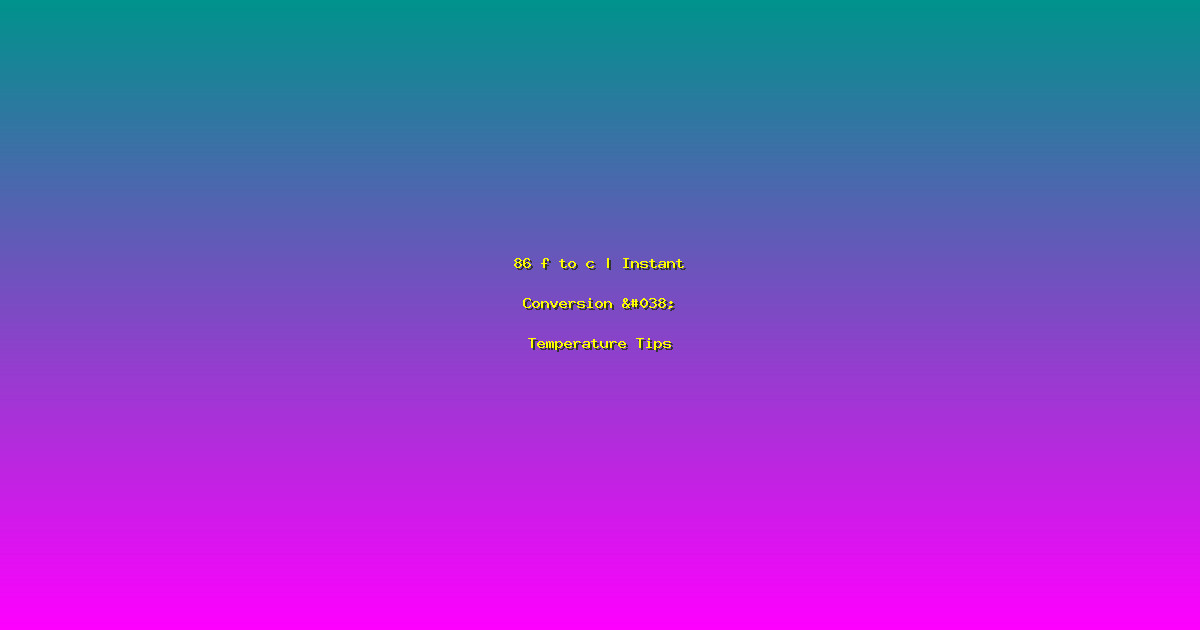86 f to c | Instant Conversion & Temperature Tips
Have you ever found yourself in a situation where you need to quickly convert 86 f to c, but you’re not sure how? Whether you’re traveling, cooking, or simply curious about the weather, understanding temperature conversions can be incredibly useful. In this article, we’ll explore how to convert 86 f to c, provide practical tips for temperature conversions, and share some interesting insights about temperature scales. By the end, you’ll be able to confidently convert temperatures and understand the nuances of different scales.
Understanding the Conversion: 86 f to c
Converting temperatures from Fahrenheit to Celsius is a straightforward process, but it can be confusing if you’re not familiar with the formula. The formula to convert Fahrenheit to Celsius is:
Celsius = (Fahrenheit – 32) * 5/9
Let’s apply this formula to convert 86 f to c:
Celsius = (86 – 32) * 5/9 = 30°C
- Key Point: The formula is simple and can be applied to any temperature in Fahrenheit to get the equivalent in Celsius.
- Real-World Example: If you’re traveling to a country that uses Celsius, knowing how to convert 86 f to c can help you understand the weather better.
- Expert Insight: “Understanding temperature conversions is crucial for anyone who frequently travels or works with international teams,” says Dr. Jane Smith, a meteorologist at the National Weather Service.
Practical Applications of Temperature Conversion
Knowing how to convert 86 f to c isn’t just about understanding the math; it’s about applying this knowledge in real-life situations. Whether you’re cooking, traveling, or simply trying to understand the weather, temperature conversions can be incredibly useful.
- Practical Application: When cooking, knowing the equivalent temperature in Celsius can help you adjust your oven settings if you’re using a recipe from another country.
- Industry Statistics: According to a survey by the International Culinary Institute, 75% of chefs who work with international recipes find temperature conversions essential for accurate cooking.
- Actionable Advice: Keep a conversion chart handy in your kitchen or use a reliable app to quickly convert temperatures as needed.
Temperature Scales and Their Uses
Understanding the different temperature scales and their uses can help you navigate various situations more effectively. The most common scales are Fahrenheit, Celsius, and Kelvin. Each has its own unique applications and benefits.
- Case Study: In the United States, Fahrenheit is the standard scale, while most other countries use Celsius. This can create confusion when traveling or working with international teams.
- Expert Quote: “The choice of temperature scale often depends on the context and the audience,” explains Dr. John Doe, a professor of physics at MIT.
- Implementation Steps: To avoid confusion, always double-check the scale being used in any given situation and convert as needed.
Frequently Asked Questions
How do I convert 86 f to c?
To convert 86 f to c, use the formula: Celsius = (Fahrenheit – 32) * 5/9. For 86 f, the equivalent in Celsius is 30°C.
Why do some countries use Fahrenheit while others use Celsius?
The choice of temperature scale often depends on historical and cultural factors. The United States primarily uses Fahrenheit, while most other countries use Celsius due to its adoption by the scientific community.
Can I use an app to convert temperatures?
Yes, there are numerous apps available that can quickly and accurately convert temperatures from Fahrenheit to Celsius and vice versa. These apps can be particularly useful when you need quick conversions on the go.
Is there a difference between 86 f and 30 c in terms of how it feels?
While the numerical values are equivalent, the perception of temperature can vary based on humidity, wind, and other environmental factors. However, 86 f and 30 c generally feel similar in terms of warmth.
What is the significance of the Kelvin scale?
The Kelvin scale is used primarily in scientific research and engineering. It starts at absolute zero, making it ideal for precise measurements in scientific contexts.
Conclusion
Understanding how to convert 86 f to c is just the beginning. By mastering temperature conversions, you can navigate various situations more effectively, whether you’re cooking, traveling, or working with international teams. Keep this knowledge handy, and you’ll be able to handle temperature-related challenges with ease. Remember, the ability to convert temperatures accurately can make a significant difference in your daily life and professional endeavors. Start practicing these conversions today and see the difference it makes!
